Growing fruits and veggies isn’t a terribly difficult endeavour—humanity has been doing it successfully for thousands of years—but it does require a certain amount of know-how, a lot of dedication, and the right environment to turn seeds into edible plants. If you struggle with all of those things, the hydroponic Rise Garden makes growing plants almost idiot-proof, but unlike your countertop bread maker, it’s definitely not a completely autonomous solution.
After moving into our first house five years ago, we had grand ambitions of turning its backyard flower garden into a miniature farm where we’d grow tomatoes, strawberries, and a wide variety of crops that would—at least in theory—save us a trip to the local farmer’s market every week in the summer. However, the local rabbit and chipmunk population had other plans. After waging war with the crop destroyers for a few years, including failed attempts to build fortifications around our crops, the siren’s song of an indoor hydroponic garden became hard to resist.
We’ve been testing the Rise Garden since February, and although our harvests have been much smaller than what we could have grown in our backyard (when it wasn’t under four feet of snow) we’ve enjoyed healthy crops of lettuces, herbs, and cherry tomatoes. But the most valuable thing to come out of our first harvest was a better understanding of what an indoor hydroponic garden entails. Most of the success of our harvest can be attributed to the Rise Garden, but if you’re going in thinking you can plant a few seeds, fill a tank with water, turn the lights on, and come back to fresh produce months later, you’re going to be disappointed.
Flat-Pack Farming
Although the Rise Garden arrives with a bit of assembly required, it still comes in a fairly hefty box—the garden’s base unit, which houses the electronics, pumps, and water tank, comes as a single pre-assembled unit. If you live in an apartment or a high-rise condo, I’d recommend doing what you can to ensure the delivery driver brings it right to your front door, instead of downstairs, as the box can be a real challenge to wrangle.
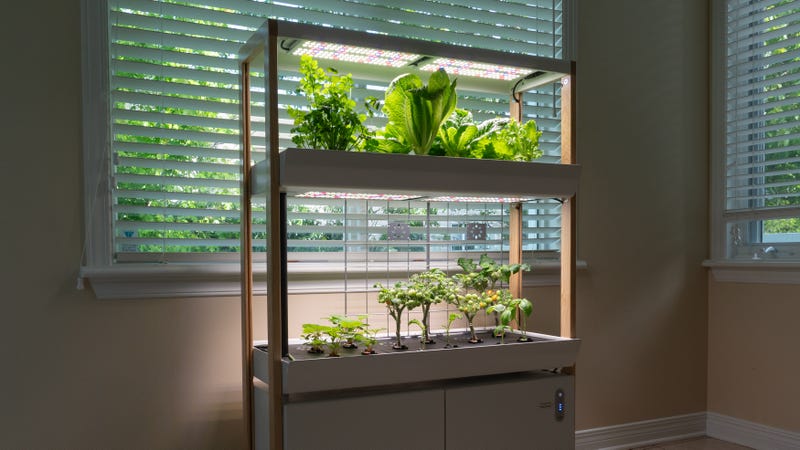
The included building instructions aren’t quite as detailed as the manuals Ikea provides. This can sometimes make the build feel more stressful than it needs to be as it involves not only construction but also running wires and plumbing pipes. Some of the assembly steps required a little more time than others to decipher to ensure they were being completed properly, and I think a version 2.0 of the instruction manual that breaks the assembly down into smaller steps would go a long way to making the Rise Garden even more user-friendly.
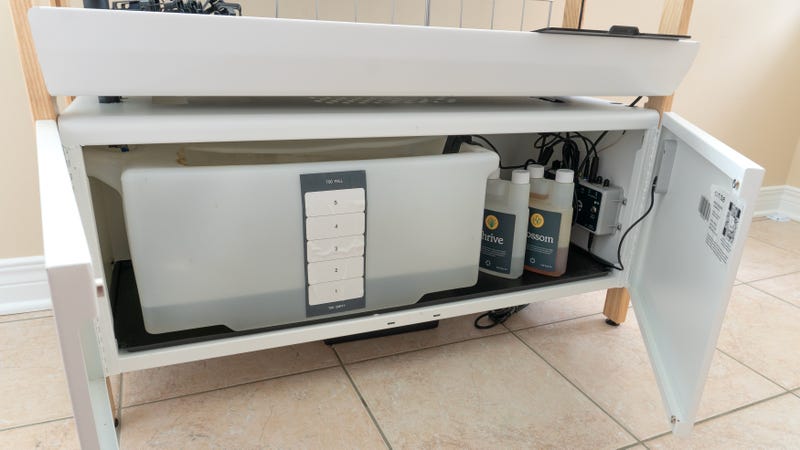
Comparing the Rise Garden to Ikea’s products isn’t exactly fair given the Swedish furniture maker has had over 50 years to polish its offerings, whereas the hydroponics startup has only been around since 2017. So occasionally you’ll spot things that feel out of place on a $US700+ indoor garden, including a very wrinkled factory-applied water level sticker on the unit’s reservoir tank.
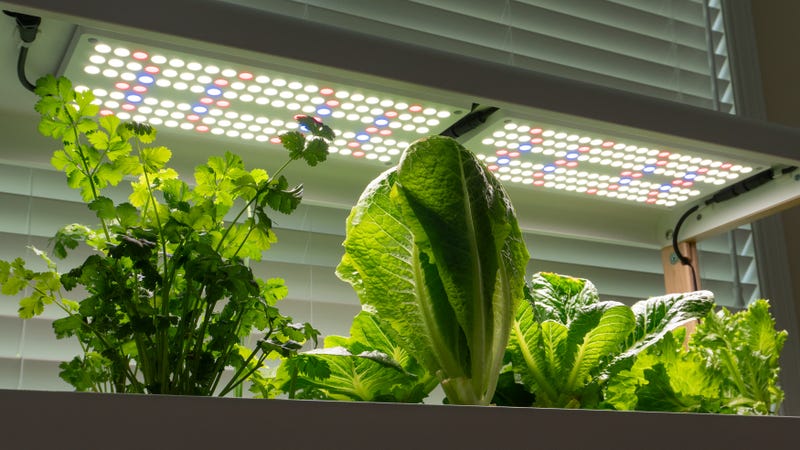
But when it’s all fully assembled, including running and then connecting various wires for the water pump and LED lighting to a control box also located in the base, the garden actually looks quite nice when it’s finished. It’s definitely not something you’ll want to hide away in the basement or an out-of-sight workroom. It feels like another piece of furniture in your home.
Another Pod-Hungry Kitchen Appliance
The Rise Garden relies on small pods, similar in size and shape to the coffee pods a Keurig uses, that can either be purchased with specific seeds already inside them, or with nothing but a biomass material (a mix of coconut fibre and peat moss) allowing users to use their own seeds. Our testing was done with pre-seeded pods, and while Rise Gardens offers a decent selection through its website, including veggies, herbs, flowers, and fruits, the selection is determined by the size of the garden and limitations like not actually having a foot of soil for veggies such as carrots and potatoes to grow in. But some root vegetables, like radishes and turnips, are still an option.

These pods are not reusable, however, and four-packs cost anywhere from $10 to $15 depending on the plant and will need to be replaced several times a year. The two-level Rise Garden we tested had enough capacity for 24 of these pods, so that’s anywhere from $60 to $90 to restock them all.
There’s No Fast-Forward Button
These pods are then inserted into special cups that allow the roots to hang down into the hydroponic garden’s constant flow of nutrient-rich water, but before they go into the actual garden, they need to first be germinated in a smaller plastic nursery—like a miniature greenhouse—filled with water that’s changed weekly.
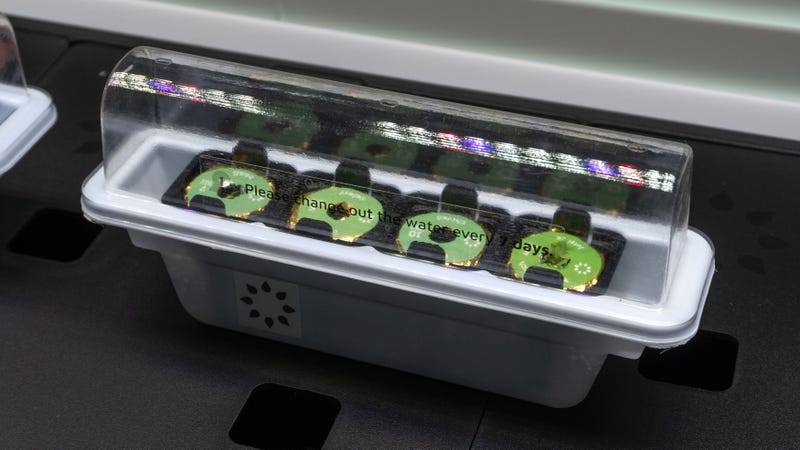
Although a backyard garden can be fast-forwarded to the good stuff by simply buying pre-sprouted plants, everything that comes from the Rise Garden has to be grown from a seed using these pods.

It’s admittedly very satisfying to see the first leaves or shoots extend from the top of the pod, but how long that takes—a few weeks, or a month—all depends on what you’re growing. Various lettuces seemed to take no time at all, while strawberries and cherry tomatoes were apparently in no rush.
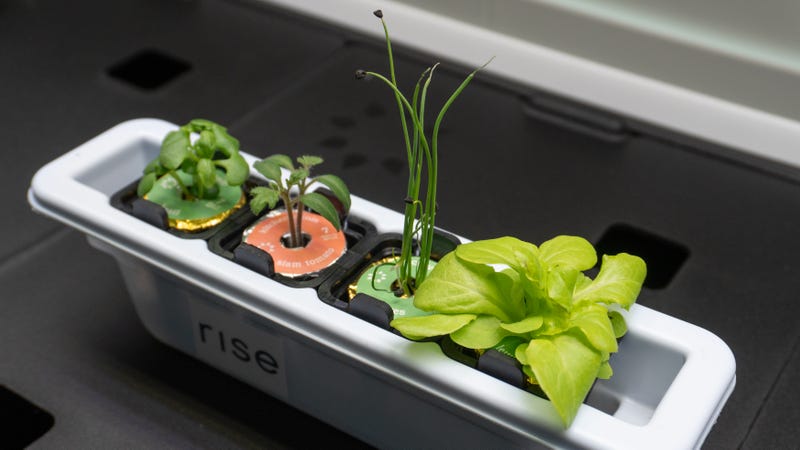
An accompanying app that connects to the Rise Garden over wifi provides a steady stream of tips and tutorials as you move through these various steps, and I’ll be the first to admit that we didn’t follow them exactly when it came to when we were supposed to move the sprouted pods from the small nursery to the garden itself.
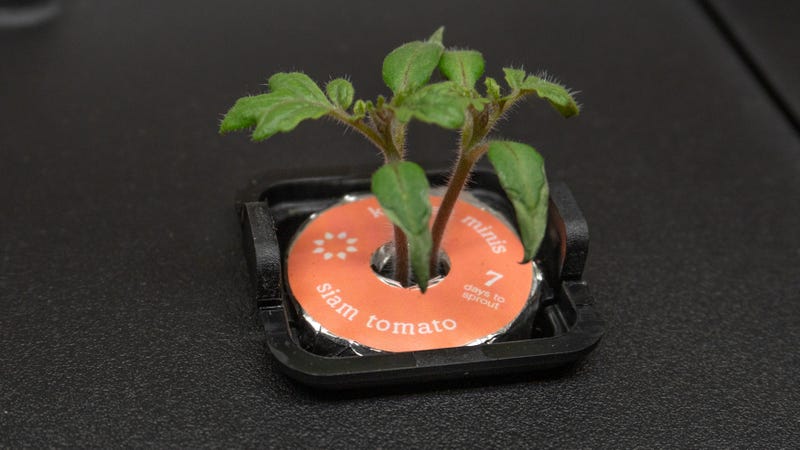
For plants like tomatoes, you’re supposed to ensure that each pod has just a single healthy shoot growing, which is something we addressed at a later point. Although the Rise Gardens app provides a wealth of information, there was still the occasional question it didn’t have an answer for, and so we treated our first batch of plants as a learning experience as we got to know the ins and outs of how a hydroponic garden works, and how it needs to be maintained. That can be an expensive approach, but as we’re planning our second crop of the year, we have a much better understanding of everything involved and improved strategies for plant selection and location.
You Don’t Have to Weed, But There’s Still Work to Be Done
After having successfully grown and harvested many different types of vegetables, the advantages of a hydroponic garden become more obvious. You don’t have to find ways to protect the plants from wildlife, you don’t need to use any insecticides, it works all year round, assuming your home isn’t freezing inside in the winter, and there’s never any weeding. But that doesn’t mean there isn’t work to be done.
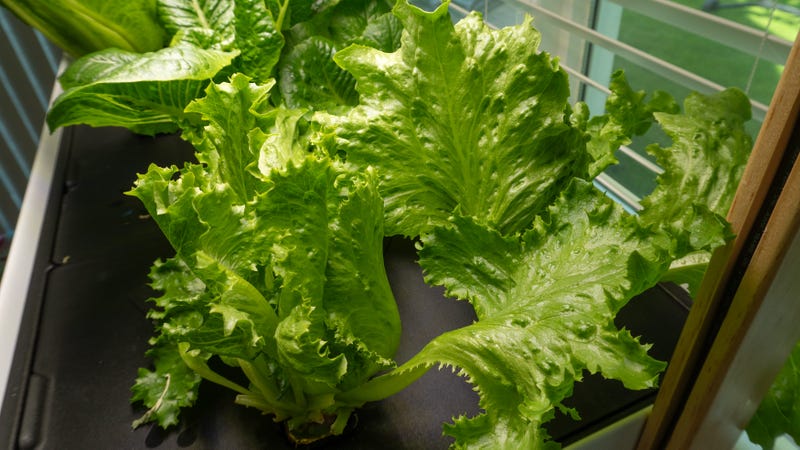
Some plants grow much faster than others (I’m looking at you, lettuces) which requires constant harvesting to ensure they don’t grow tall enough to hit the LED lighting above, while others, like tomatoes, will require pruning to give the strongest shoots the best chance at producing vegetables.
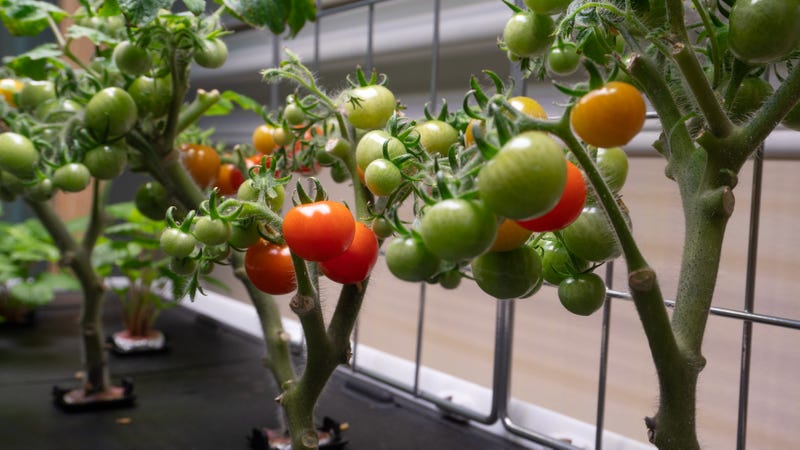
And unless you’re willing to share your home with a hive of bees, it’s also your job to properly pollinate the flowers and buds that appear. It’s an easy enough task that involves using a small paint brush to gently collect pollen and move it between flowers, but it’s something you’ll need to remember to be diligent about to maximize your garden’s output.
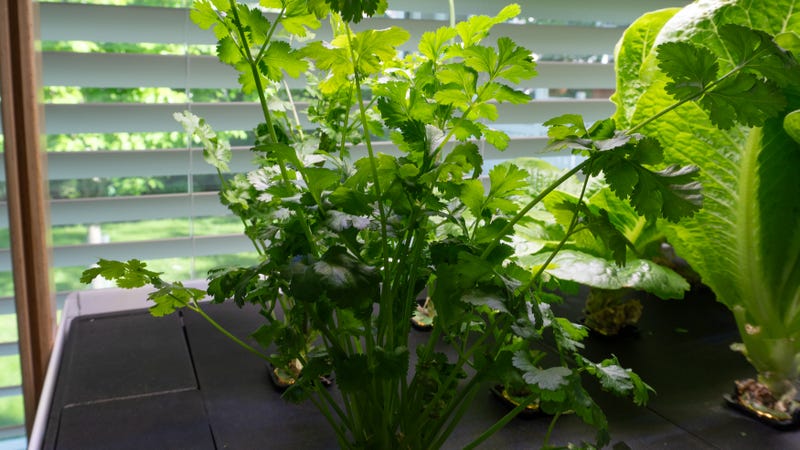
There’s also the water tank that needs to be constantly refilled, as well as liquid nutrients and other chemicals, like pH balancer, that need to be added at regular intervals, but the Rise Gardens app will prompt and remind you when those are needed, providing a checklist of tasks you need to complete. It’s like having a digital farmer working alongside you that does its best to keep tabs on the health of the system and the progress of the plants based on when they were added to the garden. But since it’s not actually using cameras or AI to visually monitor the growth progress of each plant, just timing, the app would occasionally tell us it was time to remove and throw away a plant, even when it looked perfectly healthy and was still producing vegetables.
As I said before, the Rise Garden comes with a bit of a learning curve, but it doesn’t take long to figure out how to maximize your success. And despite being completely new to indoor gardening, with the help (constant nagging) of the Rise Gardens connected app, our first crop still produced more vegetables in just a few months’ time than our backyard garden did over the past five years.
The Aftermath
Unlike a garden where a plant eventually dies, rots away, and then automatically turns into nutrients that will help next season’s crop thrive, the post-harvest cleanup with the Rise Gardens is all up to you.
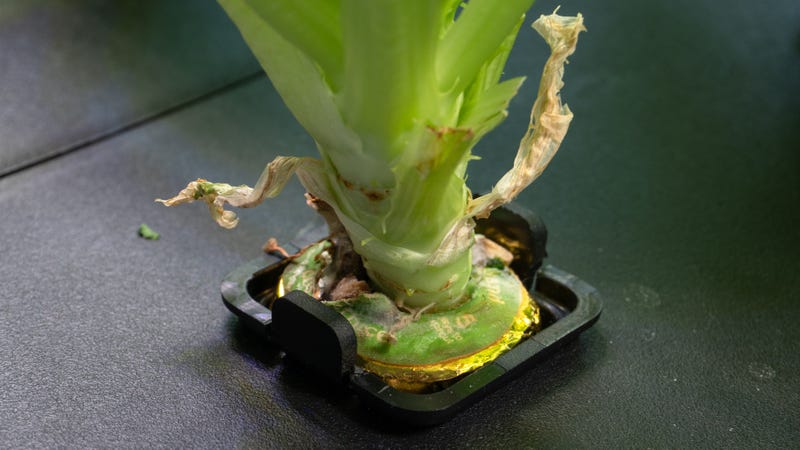
As I mentioned earlier, the Rise Gardens app will let you know when it’s time to remove and discard a plant because eventually, it could end up looking like this. Although our various lettuce plants seemed like they could go on producing fresh leaves for months, the base of the plants eventually developed mold, and even started to rot, which can affect the taste of the parts you’re trying to eat.

And then there’s the parts of the garden you don’t really see, and might not want to. Nutrient-rich water is constantly flowing through the roots of the plants on all levels, and despite the fact that you’re constantly topping up the water tank in the base with fresh water, it will eventually get quite filthy as a result of the plants, and the additives that feed them. Rise Gardens recommends you do a deep clean of the garden every four to five months, which means removing and discarding every last plant, thoroughly cleaning the water trays, water tank, and plumbing, and essentially starting from scratch. It’s time-consuming, and for larger gardens with multiple levels, it’s something you may have to do three times a year. But is it more work than maintaining a backyard garden which includes tilling the soil ahead of new plantings? Definitely not.
Should You Consider a Rise Garden?
If you’re anything like my family, and like the idea of growing a garden, but have had little success with a backyard crop exposed to the local elements, then a hydroponic garden like the Rise Garden is certainly worth considering. Gardening where we live is further complicated by snow and cold temps that often stick around until April and May, and I have to admit that just the sight of an indoor garden flourishing with green plants while it was dumping snow outside was a welcome pick-me-up when winter stretched on too long here.
We are absolutely what I would describe as irresponsible plant parents, but every single thing we planted in the Rise Garden successfully grew and produced fruits and vegetables, and what little manual maintenance was actually required from us was a very easy lift thanks to the constant nagging reminders from the Rise Gardens app. A hydroponics garden is definitely not a set-it-and-forget-it gardening solution, but it was a lot easier than tending to one outside.
What the Rise Garden is not is a cheaper alternative to the grocery store or farmer’s market for filling your kitchen with fresh produce. Even with a third level the Rise Garden’s capacity is limited both by its footprint, and the height to which plants can grow before hitting and blocking the overhead LED grow lights. The seed pods are also far more expensive than just buying a small pouch of seeds and burying them in soil, and you’ll need more than just water to be successful. For testing purposes, we used the various additives that Rise Gardens sells—four bottles which cost $US60 in total—and while they’ve lasted a few months, they won’t last forever. We’re looking into cheaper alternatives for these additives (there are countless hydroponic solutions available) it’s yet another recurring cost you need to factor in, after the initial investment.
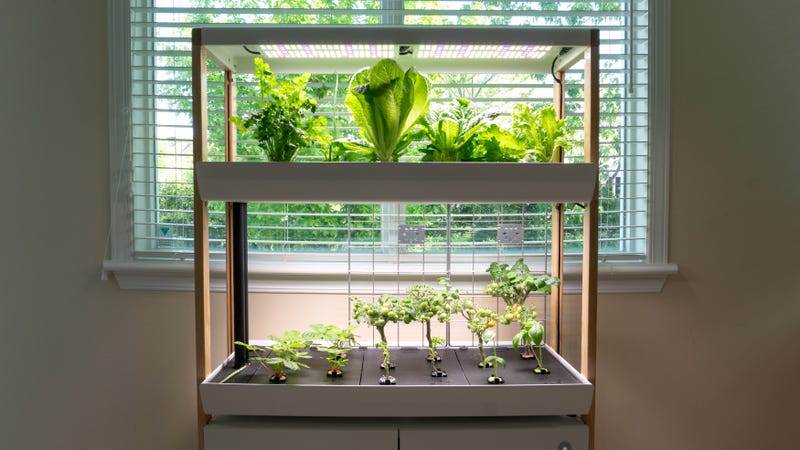
Produce on the cheap was not our goal with the Rise Garden, however. We just wanted the satisfaction of successfully growing something, and the Rise delivered. I’m not saying I’m now a full-fledged farmer, but I now know the satisfaction of standing back and nodding approvingly at a successful crop, and I’m eager to do it again.
